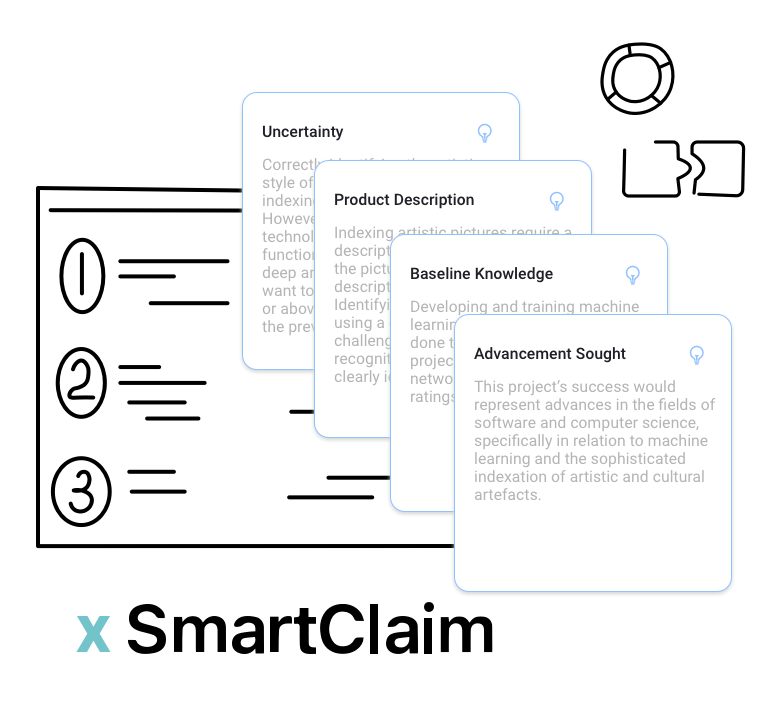
Novel is an R&D tax relief management platform that helps consultants and accountants improve their workflows, enhance team collaboration and manage their time more efficiently.

Experience a transformative approach to R&D tax relief management with Novel's comprehensive suite of features, designed to enhance efficiency, accuracy and collaboration.
Automatically pre-populate your AIF and submit your pre-notification form to HMRC without exiting the platform with Novel's one-click submit.
Auto-populated submission forms: pulls data directly from the claim preparation process, reducing duplications and errors.
Built-in compliance checks: ensure submissions meet HMRC standards before filing, reducing the risk of delays or rejections.
One-click submission: send forms directly to HMRC from within the platform and avoid unnecessary steps.
Automatic storage: every submitted form is automatically stored within Novel, creating an organised and easily accessible record for future reference.


Gain a holistic view of your R&D claims with our practice insights dashboard. The dashboard consolidates financial, technical and operational claim data into one centralised location, ensuring efficient claim management and that nothing gets missed.
Practice-level view: track R&D claim progress across multiple clients in a single dashboard.
Financial & tax insights: get real-time estimates on claim values and forecast benefits.
Efficiency metrics: identify outstanding tasks and prevent potential bottlenecks in the claim process.
We have partnered with SmartClaim to use their cutting-edge AI to support you in writing technical narratives.
Draft narratives: save hours of work by using AI to transform unstructured notes into structured technical narratives, with DSIT references.
AI hallucinations: built-in hallucination checkers ensure any hallucinations are caught and flagged to the user, ensuring accuracy and reliability.
Data security: the information you provide is not saved or used for training.


Enhance teamwork with Novel's integrated collaboration features. Assign a consultant, utilise real-time commenting, the task manager and document sharing to ensure seamless communication and a unified approach to claim preparation.
Inline comments & tagging: add comments directly on claim sections and tag colleagues for input.
Task assignment & notifications: assign tasks to team members with in-app and email notifications.
Client collaboration capability: invite your clients to Novel to provide input on claims.
Maintain accuracy and compliance with our robust review tools. Assign reviewers, leave comments, track changes and implement feedback efficiently, ensuring every claim meets the highest standards before submissions.
Approval workflow: ensure appropriate sign off by putting your claim in a review state before finalising it.
Compare past edits: view historical versions and changes throughout the process.
Choose reviewer: select who is responsible for the review and final approval of a claim.


Stay informed with real-time updates on the status of your R&D tax relief claims. Novel monitors payments, providing timely notifications and detailed tracking to keep you updated throughout the process.
Automated HMRC payment tracking: conveniently monitor the payment status of your claim within Novel.
Alerts & notifications: get timely in-app and email notifications when there are changes to the progress of your R&D claim.
Navigate the most complex and intricate tax scenarios with our state of the art built-in tax calculator. Quickly and accurately calculate tax liabilities and potential reliefs in Novel, and provide your clients with an idea of what they can expect to receive.
Pre-fill with claim data: need to quickly forecast a benefit? Pull figures directly from the R&D claim preparation workflow.
Scenario planning & adjustment: test different scenarios within minutes to review how they affect the corporation tax.
Clear reporting: generate clear and detailed PDF summaries of the calculations for client presentations.


Add your brand identity to Novel. Our white labelling feature allows you to upload personalised cover page, logo and descriptions, providing a consistent experience for your clients.
Logo integration: upload your company logo to Novel to make it your own.
Branded reports: maintain consistency across your past projects with personalised reports, descriptions and cover page.
Streamline your R&D tax relief claims by completing all the necessary tasks in one place.

Avoid unnecessary manual data entries and reduce errors through app integrations and automated prompts designed to monitor compliance.

Keep the claim up-to-date and always work on the latest information with real-time updates, audit trails and auto-sync features.

Reduce the need for endless back and forth email threads, messages and word documents by managing all your content within Novel.
Reliable software for statutory accounts and corporation tax returns is widely used within the accounting world. However, when it comes to compliant R&D tax relief claims, many advisors settle for Word and Excel. With increased regulation, scrutiny and filing requirements, complement your service with a platform that validates reports, monitors compliance and boosts productivity.